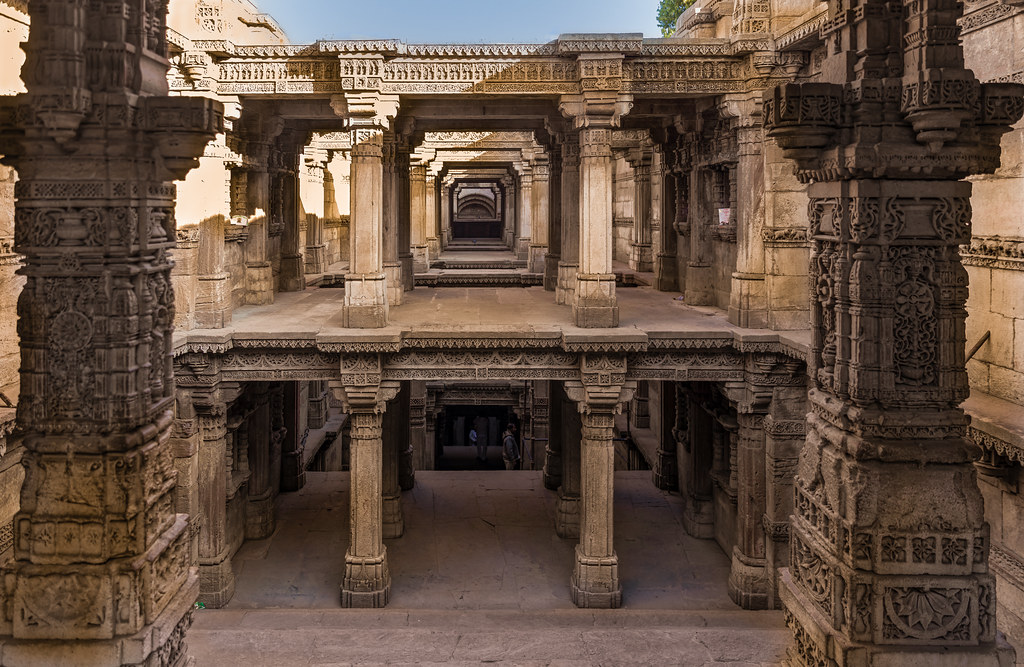Adalaj Stepwell: Gujarat, a land steeped in history and architectural marvels, is home to the Adalaj Stepwell, a subterranean masterpiece that not only served as a practical solution for water conservation but also stands as a testament to the artistic brilliance of its creators. Nestled in the quiet village of Adalaj, this stepwell is not just a well but an intricate piece of history, reflecting the fusion of functionality and artistic expression.
“Step into architectural splendor at Adalaj Stepwell, an ancient marvel near Ahmedabad, Gujarat. Admire the intricate carvings and ornate Islamic architecture that adorns the stepwell, revealing a blend of artistry and utility. Delve into the historical significance of this five-story structure, offering respite from the heat and a glimpse into the rich heritage of Gujarat. Visit Adalaj Stepwell to witness the fusion of engineering and artistry, making it a cultural gem that stands the test of time.”
Historical Roots: Adalaj Stepwell
The Adalaj Stepwell, also known as ‘Adalaj ni Vav,’ was constructed in 1499 by Queen Rudabai, wife of the Vaghela chief, Veersinh. The stepwell served as both a water source and a communal space for socializing, making it an essential part of the village’s infrastructure during its time.
Architectural Splendor: Adalaj Stepwell
The stepwell follows the traditional architectural style of Gujarat, showcasing intricate carvings, detailed friezes, and ornate pillars. The structure is a perfect blend of Indo-Islamic and Solanki architectural styles, with influences from Hindu and Jain traditions. The five-story stepwell descends into the ground with intricately carved levels that showcase the rich cultural tapestry of the time.
Symbolism and Spiritual Significance: Adalaj Stepwell
Beyond its utilitarian purpose, the Adalaj Stepwell holds symbolic and spiritual significance. The elaborate carvings depict scenes from Hindu mythology, showcasing gods, goddesses, and mythical creatures. The stepwell was not only a place for water storage but also served as a place for meditation and reflection, emphasizing the interconnectedness of practicality and spirituality in the lives of the people.
Architectural Elements:
The stepwell is characterized by its octagonal well shaft, pillared pavilions, and intricately carved niches. The walls of the stepwell are adorned with sculptures of deities, floral motifs, and geometric patterns. The intricate detailing on the pillars and walls reflects the artisanal excellence of the craftsmen of that era.
Functional Design:
The stepwell is designed to facilitate easy access to water even during the driest months. The steps, adorned with landings and resting areas, allowed the villagers to descend to the water level and collect water for daily use. The architectural ingenuity of the stepwell ensures that it remains cool even during scorching summers, providing respite to those seeking shelter.
Preservation Efforts:
Recognizing its cultural and historical importance, the Adalaj Stepwell has been declared a protected monument by the Archaeological Survey of India (ASI). Conservation efforts are ongoing to preserve the stepwell and its intricate carvings, ensuring that future generations can appreciate the architectural legacy it represents.

Conclusion:
In conclusion, the Adalaj Stepwell is not just a relic of the past; it is a living testament to the artistic prowess, cultural richness, and pragmatic innovation of the people of Gujarat. As visitors descend its steps and marvel at the intricacies of its carvings, they are transported to an era where aesthetics and functionality coexisted harmoniously. The Adalaj Stepwell remains a cherished heritage site, inviting all to appreciate the beauty that lies beneath the surface, both metaphorically and literally.

